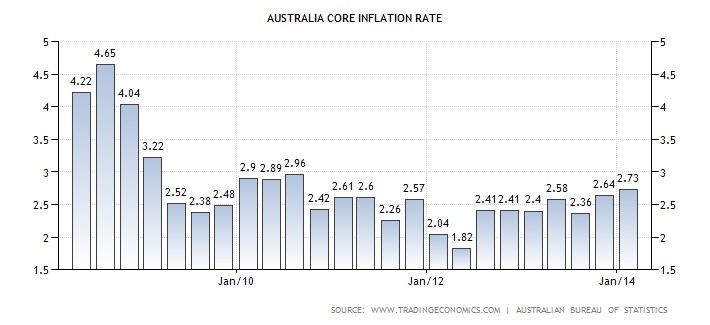The local sharemarket rose to a new six year high, money market interest rates fell, as did the Aussie dollar, which dropped under 93 USc.
The immediate catalyst was the weaker than expected March quarter consumer price index reading, and then the flash report on the health of Chinese manufacturing which showed another month of weakness.
It was yet another example of how markets had worked themselves into a froth over nothing.
The headline inflation for the first-quarter of this year rose by 0.6% to take the annual rate to 2.9%, just under the Reserve Bank’s 2% to 3% top of its target range.
Even better the average of the RBA’s preferred measures, the weighted median and the trimmed mean (up 0.6% and 0.5% respectively in the quarter) was an annual rate 2.65%, well within the RBA’s range and a result the central bank will be very comfortable with.
The Australian dollar fell by more than half a cent to 93.21 USc after the CPI was released at 11.30 am.
It then fell further, under 93c after the Chinese manufacturing report was released. It was trading around 93.80 this morning – all up it lost close to a cent yesterday and overnight.
Australian shares rose 0.7%, supported by another day of investor buying of banks and consumer stocks, such as retailers.
ASX 200 index advanced for its fifth consecutive session of gains, up 38.5 points at 5517.8, its highest close since June 2008.
It reached a new six-year high of 5521.4 in trading. The All Ords was up 35 points to close at 5502.2.
For the second day in a row Westpac and ANZ hit fresh all time highs, both rising 0.9% to $35.62 and $34.59, respectively.
Economists had forecast an 0.8% quarterly rise for headline inflation and an annual growth of 3.2% and an 0.7% rise in the underlying rate (to take that to 2.9%). They were wrong.
In fact the CPI report ended up more important than it should have been because it was lower than anyone had expected, despite price pressures coming from a collection of government decisions and price rises.
That rise in the CPI in the three months to December of 0.8% pushed the annual rate to 2.7%.
That bigger than forecast rise drove the RBA’s shift towards a neutral monetary policy stance in February and its recent reticence on the value of the dollar.
But now inflation has eased, and could have been much less but for a spate of price rises linked to government decisions.
Inflation under control, dollar falls

In its commentary, the Bureau of Statistics said "the most significant price rises this quarter were for tobacco (+6.7%), automotive fuel (+4.1%), secondary education (+6.0%), tertiary education (+4.3%), medical and hospital services (+1.9%) and pharmaceutical products (+6.1%)".
"These rises were partially offset by falls in furniture (-4.3%), maintenance and repair of motor vehicles (-3.3%), international holiday travel and accommodation (-2.4%) and domestic holiday travel and accommodation (-2.4%).
"The tobacco price increase was caused by the federal excise tax rise from 1 December 2013 as well as the March 2014 biannual indexation based on the ABS’ Average Weekly Ordinary Times Earnings (AWOTE) rate.
"Education prices have risen with the commencement of the new school year.
"Rises for medical and hospital services and pharmaceutical products were a result of the cyclical reduction in the proportion of patients who qualify for subsidies under the Medicare Benefits Scheme and Pharmaceutical Benefits Scheme at the start of each calendar year," the ABS commented.
Without those government-linked price rises, the CPI may not have risen very much at all in the quarter.













